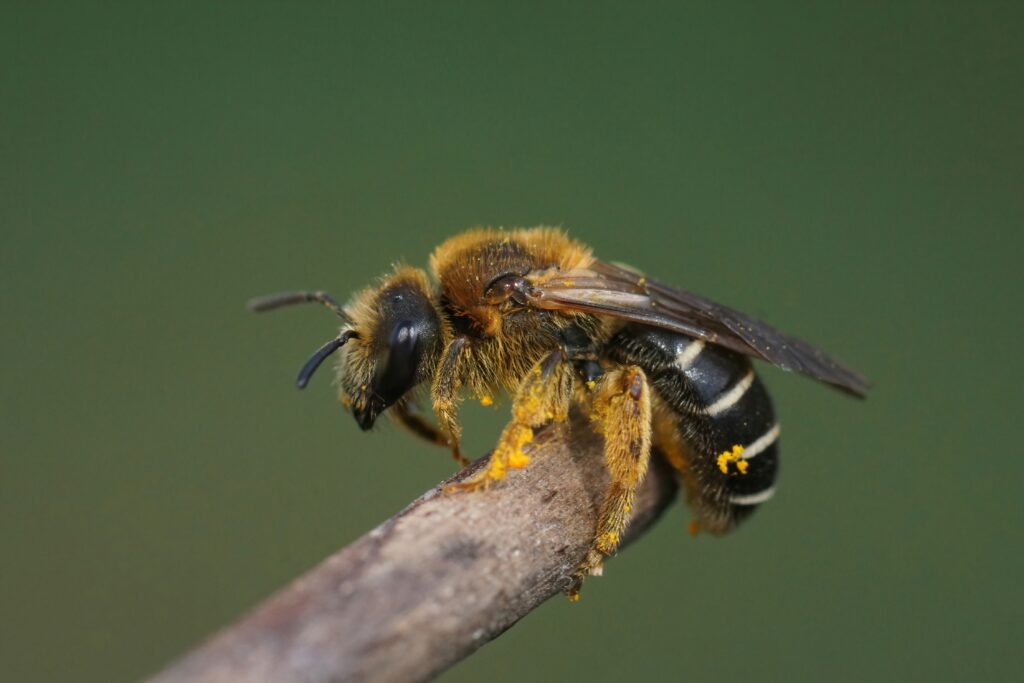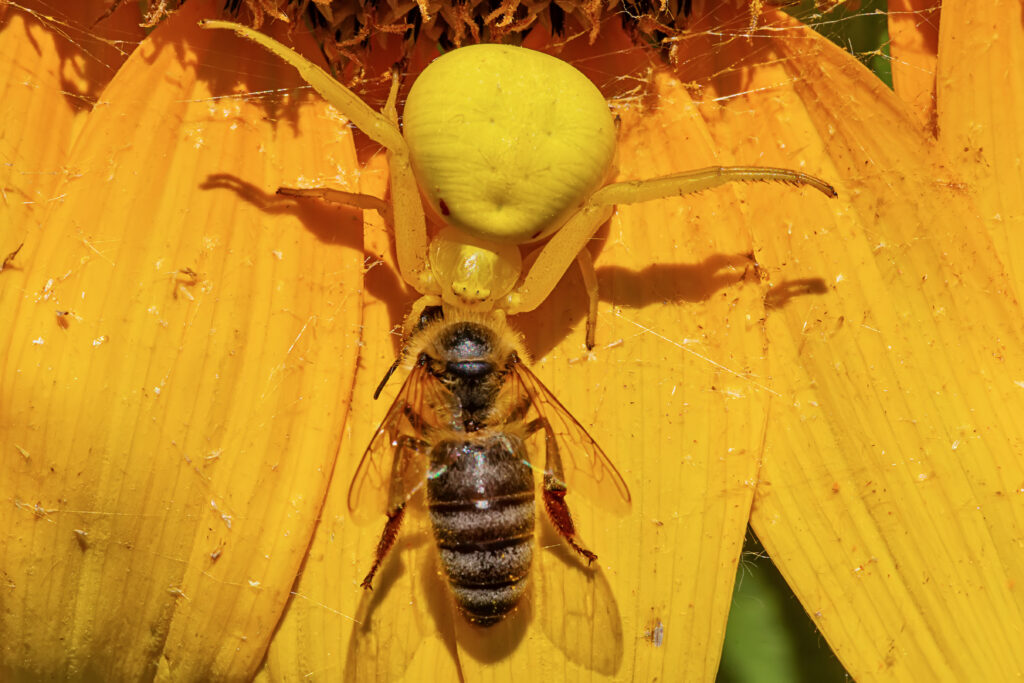Furrow Bee
Fossils of the Halictidae family have been discovered in amber that is between 96 and 75 million years old!
Advertisement
Furrow Bee Scientific Classification
Read our Complete Guide to Classification of Animals.
Furrow Bee Conservation Status
Furrow Bee Facts
- Prey
- N/A
- Main Prey
- N/A
- Name Of Young
- larvae
- Group Behavior
- Solitary
- Fun Fact
- Fossils of the Halictidae family have been discovered in amber that is between 96 and 75 million years old!
- Estimated Population Size
- Undetermined
- Biggest Threat
- Habitat loss
- Most Distinctive Feature
- metallic colors
- Distinctive Feature
- buzz pollination
- Other Name(s)
- sweat bee
- Gestation Period
- 3-5 days
- Temperament
- docile
- Wingspan
- 0.20 - 0.60 inches (5-15 mm)
- Training
- N/A
- Optimum pH Level
- N/A
- Incubation Period
- 3 weeks
- Age Of Independence
- 6-8 weeks (emergence)
- Age Of Fledgling
- 6-8 weeks (emergence)
- Average Spawn Size
- 10-100
- Litter Size
- N/A
- Habitat
- meadows, woodlands, deserts, wetlands
- Predators
- birds, spiders, small mammals, other insects
- Diet
- Herbivore
- Average Litter Size
- N/A
- Lifestyle
- Diurnal
- Crepuscular
- Favorite Food
- Flower nectar
- Type
- Halictus
- Common Name
- furrow bee
- Special Features
- Buzz pollinators
- Origin
- Asia
- Number Of Species
- 330
- Location
- Global, but more abundant in the Northern Hemisphere
- Slogan
- N/A
- Group
- colony
- Nesting Location
- ground, plant stems, wood
- Age of Molting
- various times throughout larval development
Furrow Bee Physical Characteristics
- Color
- Brown
- Yellow
- Fawn
- Black
- Tan
- Green
- Chocolate
- Multi-colored
- Grey-Brown
- Golden
- Skin Type
- Exoskeleton
- Lifespan
- 4 weeks - 1 year
- Weight
- less than 1 ounce
- Height
- 0.05 inches
- Length
- 0.20 - 0.60 inches (5-15 mm)
- Age of Sexual Maturity
- 1-3 days post emergence
- Age of Weaning
- N/A
- Venomous
- No
- Aggression
- Low
View all of the Furrow Bee images!
Furrow bees (Halictus) belong to the family Halictidae, the second-largest family of bees in the world! The family Haliciodae contains approximately 4,500 species. The genus Halictus contains over 330 species across 15 subgenera. North America is home to approximately 25 separate species of Halictus. They are found on every continent except Antarctica. The majority, however, occur in the Northern Hemisphere. All bee species in the genus Halictus are commonly known as furrow bees, given that they are ground-nesting bees that construct their nests in soil or sandy substrates by digging small tunnels and creating chambers for their offspring. Halictus are effective pollinators. They range in size from small, solitary species to larger, social species with complex nests and hierarchies. Keep reading to discover more about this fascinating genus of bees!
Scientific Name
The name Halictus was first used by the Swedish entomologist Carl Linnaeus to describe this group of bees in his book Systema Naturae which was first published in 1735. The name Halictus is derived from the Greek word hali meaning salt and ictus which refers to the pulse, or a recurring rhythm. This is a fitting moniker for this genus of sweat bees, which are attracted to perspiration for its sodium.
Furrow Bee: Appearances
The appearance of furrow bees can vary significantly depending on the species and individual. As there are over 300 separate species of these bees, it follows that they exhibit a variety of shapes and sizes. In general, they are small to medium-sized bees, ranging from 0.20 – 0.60 inches (5-15 mm) in length. They are often slender with narrow waists and long antennae.

The appearance of furrow bees can vary significantly depending on the species and individual.
Halictus rubicundus, the orange-legged furrow bee, pictured.
©HWall/Shutterstock.com
The coloration of furrow bees varies widely. While some species are predominantly brown/black (Halictus ligatus, the ligated furrow bee), others have distinctive yellow markings (Halictus subauratus, the golden furrow bee), or metallic bodies (Halictus hotoni, Hoton’s metallic furrow bee). Some species have hairy or fuzzy bodies (Halictus tripartitus, tripartite sweat bee) while others have smooth, shiny abdomens (Halictus sexcinctus, the six-banded furrow bee). Males are often more brightly colored than females. There are considerable differences depending on the species and individual in this genus of fascinating bees.
Behaviors
The behavior of furrow bees is quite different across the 300+ species. While most are solitary, others are eusocial or communal. Some species like Halictus rubicundus, the orange-legged furrow bee, can be either eusocial or solitary, depending on their location. Halictus rubicundus living in cooler climates tend to be solitary, while orange-legged furrow bees found in warmer climates are generally eusocial. The majority of these bees, however, do not live in colonies and do not have hierarchies.
Nesting Behavior
Female furrow bees construct individual nests. The nest may be located in the soil, in plant stems, or in other crevices. The female will provision her nest with pollen and nectar, depositing her eggs on the food mass. The number of eggs that a female Halictus ligatus will deposit depends on several factors, including her body size, resource availability, and the quality and availability of nesting sites. However, female Halictus bees are capable of producing 1-10 eggs per day and will continue to deposit eggs until they have depleted their fat reserves. The total number of eggs deposited by a female furrow bee during her lifetime can range from a few dozen to over one hundred, depending on the factors mentioned above. Once the larvae hatch, they feed solely on the provisions, developing inside the nest.
There are a few species of furrow bees that do live in groups or clusters and may construct their nests in close proximity to one another. These species are still considered solitary, as each individual female constructs and provisions her own nest, but they may benefit from the proximity of other nests in terms of reduced predation risk or increased opportunities for mating. These bees are a diverse group of bees with a variety of nesting behaviors, but most are solitary.
Buzz Pollination
Furrow bees are one of the few groups of bees known to use buzz pollination to extract pollen from flowers. Buzz pollination is a behavior in which the bee grabs onto a flower with its mandibles and rapidly contracts its flight muscles to produce a buzzing sound. This vibration causes the flower to release its pollen, which the bee can then collect to use in provisioning its nest.
Buzz pollination is relatively rare among bees, with only a few groups known to possess this ability. Furrow bees are particularly adept at buzz pollination and are known to visit a wide variety of flowers that require this type of pollen extraction. This unique behavior highlights the complex and specialized relationships between bees and the plants they pollinate and highlights the importance of preserving the diversity of pollinators in natural ecosystems.
Furrow Bee: Habitats
Halictus are found in a variety of habitats throughout North America, including forests, grasslands, deserts, and wetlands. Different species have adapted to different environments, with some preferring to nest in the soil or in hollow plant stems, while others build their nests in wood. Some species are more common in urban or suburban environments and can be found nesting in gardens and lawns. Furrow bees are a diverse group of bees that have adapted to a wide range of habitats and environments, making them an important component of many ecosystems.
Diets
Furrow bees are generalist foragers. Generalist foragers feed on a variety of plants. Adults feed on nectar and pollen from flowering plants, which provide them with the energy they need to fly and perform their daily activities. They also collect pollen from flowers to provision brood cells for their developing offspring. The specific diet of these bees will vary depending on the species and their location.
Furrow Bee: Predators and Threats
Predators
Furrow bees have a variety of natural predators that they must contend with to survive. Spiders, like crab spiders (Thomisidae), will ambush their prey, while orb weavers (Araneidae) spin webs near flowers or other places where bees are likely to be snagged in their webs.

Crab spiders will ambush foraging bees.
©Nenad Nedomacki/Shutterstock.com
Birds like Swallows and flycatchers eat furrow bees. These birds may catch bees in midair or pluck them from flowers or other surfaces. Mammals like shrews and bats feed on a variety of insects, including bees. Other insects prey on furrow bees. Mantids, assassin bugs, and robber flies, known for their predatory habits, all eat furrow bees. Wasps and flies parasitize Halictus These parasitic insects will attach their eggs to host larvae/brood cells. Once they hatch, the parasitoid’s larvae feed on the host’s larvae, killing them. Other insects prey on furrow bees.
Threats
Halictus face a variety of threats that can negatively affect their populations. Some of the most significant threats to furrow bees include:
- Habitat loss and fragmentation: Natura habitats are lost as human development expands. This reduces the availability of suitable nesting sites and food sources for these bees.
- Pesticide: The use of pesticides in agriculture has negative effects on bee populations. Pesticides reduce the availability of food sources, harm reproductive health, and cause mortality.
- Climate change: Climate change can affect the timing of flower blooms. This disrupts the synchronization between bees and the plants they pollinate. This has a cascading effect on bee populations and plant life.
- Invasive species: Invasive plants and animals can outcompete native species for resources.
- Disease and parasites: Bees can be vulnerable to a variety of diseases and parasites.
- Poor land management practices: Poor land management practices, like overgrazing or excessive land clearing, negatively affect furrow bees’ natural habitats. Lost habitats reduce the availability of suitable nesting sites and food sources for Halictus.
Conservation Status and Population
The conservation status of the genus Halictus as a whole is impossible to determine since species have different conservation statuses. However, some species of Halictus are listed as endangered in certain regions, mainly due to habitat loss, pesticide use, and climate change. For example, the European Halictus eurygnathus, the downland furrow bee, and Halictus maculatus, the squared-headed furrow bee, are listed as endangered by NBN Atlas, the United Kingdom’s repository of biodiversity information. Population estimates for the genus Halictus are challenging to obtain due to their vast distribution and the lack of comprehensive data. Nonetheless, some species have been documented to have experienced declines in population numbers, emphasizing the importance of conservation efforts to protect these vital pollinators
Furrow Bee: Lifespan
The lifespan of Halictus can vary depending on several factors, including the species, environmental conditions, and availability of food resources. In general, however, adult furrow bees have a relatively short lifespan of several weeks to a few months. The female bees typically spend much of their time building nests, collecting pollen, and laying eggs, which can shorten their lifespan compared to males, which do not engage in these activities. The larvae that hatch from the eggs laid by the female bees also develop relatively quickly, taking only a few weeks to complete their development before emerging as adults. Once they reach adulthood, these bees continue to live for a short period before dying. Some species of Halictus overwinter as pupae, while others overwinter as adults.
North America Furrow Bee Species
A sample of North American Furrow Bees:
- Halictus confusus – the Southern bronze furrow bee or the confused sweat bee
- Halictus ligatus – the ligated furrow bee
- Halictus virgatellus – the comma sweat bee
- Halictus rubicundus – the orange-legged furrow bee
- Halictus tripartitus – tripartite sweat bee
- Halictus farinosus – Brown-winged furrow bee
- Halictus poeyi – Poey’s furrow bee,
- Halictus parallelus – parallel-striped sweat bee
- Halictus harmonious – a localized species to California
Furrow Bee FAQs (Frequently Asked Questions)
What do furrow bees look like?
The appearance of furrow bees can vary significantly depending on the species and individual. As there are over 300 separate species of these bees, it follows that they exhibit a variety of shapes and sizes. In general, they are small to medium-sized bees, ranging from 0.20 – 0.60 inches (5-15 mm) in length. They are often slender with narrow waists and long antennae. The coloration of furrow bees varies widely. While some species are predominantly brown/black, others have distinctive yellow markings or metallic bodies. Some species have hairy or fuzzy bodies while others have smooth, shiny abdomens Males are often more brightly colored than females.
Where do furrow bees live?
Furrow bees are found in every part of the world except Antarctica. In North America, furrow bees live in forests, grasslands, deserts, and wetlands. Different species have adapted to different environments, with some preferring to nest in the soil or in hollow plant stems, while others build their nests in wood. Some species are more common in urban or suburban environments and can be found nesting in gardens and lawns.
What predators do furrow bees face?
Furrow bees have a variety of natural predators that they must contend with to survive. Spiders, like crab spiders (Thomisidae), will ambush their prey, while orb weavers (Araneidae) spin webs near flowers or other places where bees are likely to be snagged in their webs. Birds like Swallows and flycatchers eat furrow bees. These birds may catch bees in midair or pluck them from flowers or other surfaces. Mammals like shrews and bats feed on a variety of insects, including bees. These bees are preyed upon by other insects. Mantids, assassin bugs, and robber flies, known for their predatory habits, all eat furrow bees.
What do furrow bees eat?
Furrow bees are generalist foragers. Generalist foragers feed on a variety of plants. Adult furrow bees feed on nectar and pollen from flowering plants, which provide them with the energy they need to fly and perform their daily activities. They also collect pollen from flowers to provision brood cells for their developing offspring. The specific diet of these bees will vary depending on the species and their location.
Are furrow bees endangered species?
The conservation status of the genus Halictus as a whole is impossible to determine since species have different conservation statuses. However, some species of Halictus are listed as endangered in certain regions, mainly due to habitat loss, pesticide use, and climate change. For example, the European Halictus eurygnathus, the downland furrow bee, and Halictus maculatus, the squared-headed furrow bee, are listed as endangered by NBN Atlas, the United Kingdom’s repository of biodiversity information.
Thank you for reading! Have some feedback for us? Contact the AZ Animals editorial team.
Sources
- vtecostudies.org, Available here: https://val.vtecostudies.org/projects/vtbees/halictus/
- bugguide.net, Available here: https://bugguide.net/node/view/12488
- wikipedia.org, Available here: https://en.wikipedia.org/wiki/Halictidae
- wikipedia.org, Available here: https://en.wikipedia.org/wiki/Halictus
- ufl.edu, Available here: https://entnemdept.ufl.edu/creatures/misc/bees/halictid_bees.htm
- mo.gov, Available here: https://mdc.mo.gov/discover-nature/field-guide/halictid-bees-sweat-bees
- pensoft.net, Available here: https://zookeys.pensoft.net/article/58441/
- inaturalist.org, Available here: https://www.inaturalist.org/taxa/57677-Halictus
- beeswiki.com, Available here: https://beeswiki.com/furrow-bees/
- museumoftheearth.org, Available here: https://www.museumoftheearth.org/bees/diversity
- inaturalist.org, Available here: https://www.inaturalist.org/guide_taxa/369950
- ufl.edu, Available here: https://edis.ifas.ufl.edu/publication/IN897
- usda.gov, Available here: https://www.fs.usda.gov/wildflowers/pollinators/pollinator-of-the-month/halictid_bees.shtml
- echinaceaproject.org, Available here: https://echinaceaproject.org/field-guides/bee/halictidae/halictus/
- greatsunflower.org (1970) v=https://www.greatsunflower.org/halictus
- itis.gov, Available here: https://www.itis.gov
- nbnatlases.org, Available here: https://species.nbnatlas.orghttps://www.xerces.org/endangered-species/species-profiles/at-risk-bees/halictus-harmoniushttps://www.xerces.org/endangered-species/species-profiles/at-risk-bees/halictus-harmonius

















